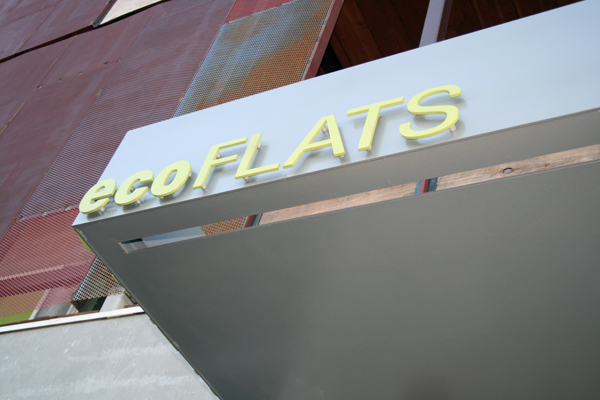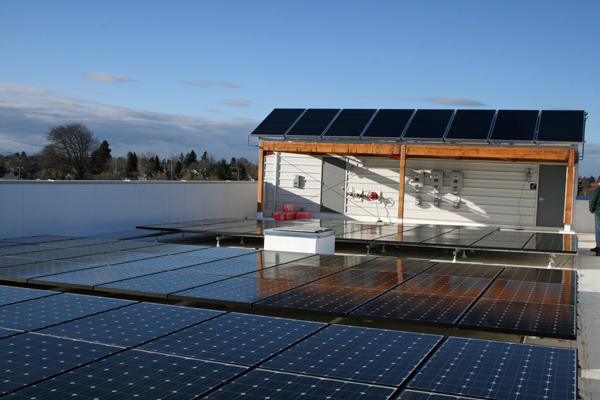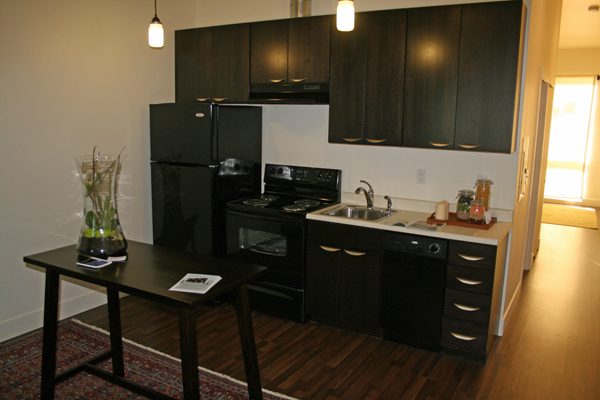When you consider Portland, Oregon, as a model of sustainability, one thing that always stands out is its well established biking community. Bike friendly roads dot the city, with several major roadways in particular acting as major commuting arteries for Portland’s cyclists each day. It is on one of these roadways that developer JeanPierre Velliet has opened EcoFlats, a very green focused apartment building that is geared towards the lifestyle of those who cycle on by.
EcoFlats, which just recently became available for rentals, is Velliet’s vision of what a green building should be: built in an urban renewal area, designed to net zero energy standards, sporting solar panels on the roof and making use of an array of green building technologies. To find out more about EcoFlats, we recently visited with him on site as construction was being completed.

EarthTechling (ET): What is your background when it comes to sustainable development?
JeanPierre Velliet: I have spent most of my adult life in the mode of resourceful sustainable design build. I was formerly trained in sculpture, but even there I was and continue to only work with found objects. My company Siteworks was begun on a bicycle with a trailer, crafting Japanese tea houses and landscape hardscape, to support my art habit. I grew from that and later connected larger design concepts to building, first in homes and eventually in the commercial world. When LEED came to town I began to figure out with everyone how to put these projects together, and I completed an early development project for Kevin Cavenaugh here in Portland named “Ode to Roses”.
The last 10 years have mostly been spent in the commercial world focusing on green retail design for Portland companies Like Nau, Lizard Lounge, Keetsa, and several sustainably minded restaurants/ breweries like Hopworks, Genoa, Accanto, Andina, Taqueria Nueve, as well as office structures like Urban Works, and several more in the works.
ET: Talk a little about the EcoFlats development. What makes it particularly interesting?
Velliet: EcoFlats is a low energy consuming project that connects people to simple guilt free, transportation oriented living. The central location allows that most needs are reachable by bike, while Zip Cars are available out front at a discount to inhabitants. One person can accomplish more for their environment by living in this way. EcoFlats as a building that consumes 65% less energy, plus renewables. I like that the technology is socially engineered, and that ideally the population works together as a community towards positive goals of even less energy consumption. EcoFlats increases the quality of life through design, and tames the individual’s draw on our resources.
ET: Explain more about some of the green technologies present in the development, including the solar power system.
Velliet: Nature already is beautiful, sustainable, and efficient by design. This is the basis of the concept, we do not need gizmos to make us more efficient – we need people to participate. Where we are geographically is important, as Oregon is a temperate climate. The first realization is that we do not need to heat and cool common corridors all day, everyday so I eliminated that. I pushed the apartments to one side, and the entries to the exterior of the building. The comfort is easily achieved using the natural ventilation available from the operable windows on both sides of the units, then added simple fans to move air, and in doing so eliminated the cooling load entirely. The siding is self ventilating to keep the building from over heating too. These techniques work great in our geographical location.

Further we used Energy Star appliances, LED lighting, day lighting, solar shading, and large doses of solar thermal and PV. The solar piece drove a lot of the building design because of its expense and necessity. I wanted to afford the largest solar array possible while still being able to deliver to the apartment community for the rents available there. We ended up with a 200K solar array, so that meant we had to accumulate a savings of 200K in other areas of the building. Mostly the elimination of internal lighting and AC equipment was the trade off. The PV portion is a grid tied 21 KW system.
The thermal portion is what you see up higher on the trellis and it is able to generate 2 gallons of 180 deg hot water per minute. We have 500 gallons of glass lined storage on the roof top ready for the domestic use. The boiler controls the heat only hydronic loop that runs through the building, requiring very efficient and easily serviceable heat to the entire building. Low flow water devices are at every fixture, and the re-sawn and reclaimed timbers from the building we removed can be seen in the exterior walk ways and solar trellis.
ET: Why go for apartments and not condos on the EcoFlats project?

Velliet: Apartments are accessible to a larger community then condos. If we are going to make real change we have to involve the majority of people. It also is not enough to do one apartment building, it has to become a paradigm shift resulting in a new way of doing things on a larger scale. Currently our entire civilization stands to be looked back upon by our future civilizations as the most destructive to have inhabited the earth, mainly for how we have been wastefully using energy, food and water on the colossal scale. Ancient cultures whom over harvested their resources themselves were lost, now that the larger world is connected in the process the consequences are interconnected and devastating.
We need to look at larger populations to make change, and by that I mean the majority of the people that have a more direct need to consumption.
ET: Why is it so important, in your opinion, for projects like EcoFlats to try to be able to exist at least partially off the grid?
Velliet: The grid is aging and I like the idea of investing the expected trillions to rebuild it into self sufficient buildings with solar, wind turbine and other means. EcoFlats is grid tied now and I enjoy the fact we do not have to employ batteries, but I am hoping for a better solution on that front in the next 10 years.
I like the idea of a limit to available energy consumption as a way to regulate our needs. We are still learning what the tipping point is between quality of life and availability of energy. I have a hunch that given a defined amount we are more conscious and better served as a whole.